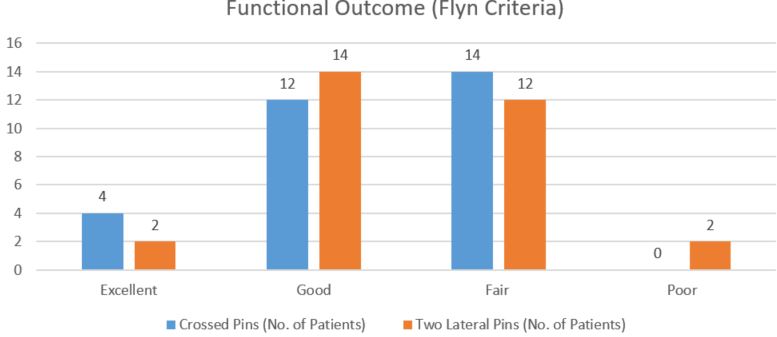Comparative study of two techniques of percutaneous pinning of displaced supracondylar humerus fracture
Abstract
Background: supracondylar fractures of the humerus are very common fractures in paediatric age groups. If displaced, preferred treatment is close reduction with percutaneous K-wire fixation. This study compares the functional outcome of cross K-wires Vs lateral K-wires in Gartland type III supracondylar humerus fractures in paediatric age groups
Methods: 60 cases of supracondylar fractures of the humerus Gartland type III in children operated with closed reduction and pinning of which 30 were of lateral and 30 were of cross K wire groups from January 2015 to June 2017 with minimum 4 months follow-up period were included.
Results: Functional outcome of the patients was assessed by Flynn’s criteria. Results were excellent 13.33 %, good 40% fair 46.6% in cross K wire group and excellent 6.6 %, good 46.6%, fair 40% and poor 6.6 % in lateral K wire group.
Conclusion: Both lateral entry pin fixation and crossed pin fixation are effective in the treatment of Gartland type III extension supracondylar fractures of the humerus in children.
Downloads
References
2. Yadav UB, Singhal R, Tonk G, Aggarwal T, Verma AN. Crossed pin fixation in displaced supracondylar humerus fractures in children. Indian J Orthop 2004;38:166-9.
3. Mazda K, Boggione C, Fitoussi F, Penneçot GF. Systematic pinning of displaced extension-type supracondylar fractures of the humerus in children. A prospective study of 116 consecutive patients. J Bone Joint Surg Br 2001;83:888-93.
4. Sudheendra PR, Nazareth EL. A comparative study of outcome of percutaneous lateral and crossed pinning in the treatment of type III supracondylar fractures of humerus in children. Sch J Appl Med Sci 2014;23:959-62.
5. Attenborough CG. Remodeling of the humerus after supracondylar fractures in childhood. J Bone Joint Surg Br 1953;35:386-95.
6. Ramsey RH, Griz J. Immediate open reduction and internal fixation of severely displaced supracondylar fractures of the humerus in children. Clin OrthopRelat Res 1973;131-2.
7. Nacht JL, Ecker ML, Chung SM, Lotke PA, Das M. Supracondylar fractures of the humerus in children treated by closed reduction and percutaneous pinning. ClinOrthopRelat Res 1983;203-9.
8. Fowles JV, Kassab MT. Displaced supracondylar fractures of the elbow in children. A report on the fixation of extension and flexion fractures by two lateralpercutaneous pins. J Bone Joint Surg Br 1974;56:490-500.
9. Mostafavi HR, Spero C. Crossed pin fixation of displaced supracondylar humerus fractures in children. ClinOrthopRelat Res 2000;56-61.
10. Bhuyan BK. Close reduction and percutaneous pinning in displaced supracondylar humerus fractures in children. J ClinOrthop Trauma 2012;3:89-93.
11. Rijal KP, Pandey BK. Supracondylar extension type III fractures of humerus in children: Percutaneous cross-pinning. Kathmandu Univ Med J 2006;4:465-9.
12. Lee SS, Mahar AT, Miesen D, Newton PO. Displaced paediatric Supracondylar humerus fractures: Biomechanical analysis of percutaneous pinning techniques. J Pediatr Orthop. 2002;22:440–3.
13. Zionts LE, McKellop HA, Hathaway R. Torsional strength of pin configurations used to fix Supracondylar fractures of the humerus in children. J Bone Joint Surg Am. 1994;76:253–6.
14. Raffi c M, MuhammedFazil VV. Percutaneous K-wire fixation of supracondylar fractures in children. J Evid Based Med Healthc 2014;1:2349-562.
15. Khan AQ, Goel S, Abbas M, Sherwani MK. Percutaneous K wiring for Gartland type III Supracondylar humerus fractures in children. Saudi Med J. 2007;28:603–6.
16. Skaggs DL, Cluck MW, Mostofi A, Flynn JM, Kay RM. Lateral-entry pin fixation in the management of Supracondylar fractures of humerus in children. J Bone Joint Surg Am. 2004;86:702–7.
17. Skaggs DL, Hale JM, Bassett J, Kaminsky C, Kay RM, Tolo VT. Operative treatment of Supracondylar fractures of humerus in children. The consequences of pin placement. J Bone Joint Surg Am. 2001;83:735–40.
18. Lyons JP, Ashley E, Hoffer MM. Ulnar nerve palsies after percutaneous cross-pinning of Supracondylar fractures in children's elbows. J Pediatr Orthop. 1998;18:43–5.
19. Royce RO, Dutkowsky JP, Kasser JR, Rand FR. Neurologic complications after K-wire fixation of Supracondylar humerus fractures in children. J Pediatr Orthop. 1991;11:191–4.
20. Agus H, Kelenderer O, Kayali C. Closed reduction and percutaneous pinning results in children with Supracondylar humerus fractures. Acta Orthop Traumatol Turc. 1999;33:18–22.
21. Pirone AM, Graham HK, Krajbich JI. Management of displaced extension-type supracondylar fractures of the humerus in children. J Bone Joint Surg Am 1988;70:641-50. Of percutaneous pin fixation in displaced supracondylar fractures of the humerus in children. J OrthopSurg (Hong Kong) 2004;12:76-82.
22. Gordon JE, Patton CM, Luhmann SJ, Bassett GS, Schoenecker PL. Fracture stability after pinning of displaced Supracondylar fractures of humerus in children. J Pediatr Orthop. 2001;21:313–840–2.

The entire contents of the Orthopaedic Journal of Madhya Pradesh Chapter are protected under Indian and International copyrights. Orthopaedic Journal of Madhya Pradesh Chapter allow authors to retain the copyrights of their papers without restrictions, Authors grant the publisher the right of exclusive publication. The Journal then grants to all users a free, irrevocable, worldwide, perpetual right of access to, and a license to copy, use, distribute, perform and display the work publicly and to make and distribute derivative works in any digital medium for any reasonable non-commercial purpose, subject to proper attribution of authorship. The journal also grants the right to make numbers of printed copies for their personal non-commercial use under Creative Commons Attribution-Non-commercial share alike 4.0 International Public License.

 OAI - Open Archives Initiative
OAI - Open Archives Initiative












